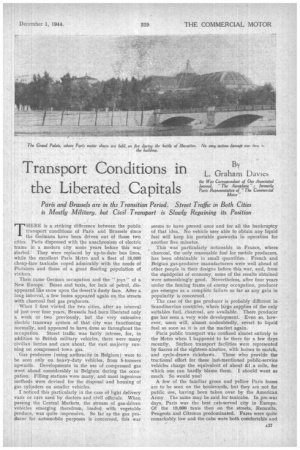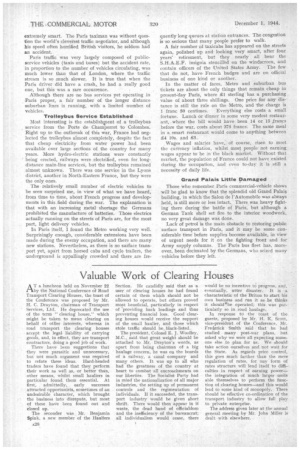Transport Conditions in the Liberated Capitals
Page 29

Page 30

If you've noticed an error in this article please click here to report it so we can fix it.
Paris and Brussels are in thz Transition Period. Street Tiaffic in Both Cities is Mostly Military. hut Civil Transport is Slowly Regaining its Position
By L. Graham Davies
the War Correspondent of Our Associated Journal, " The Aeroplane" ; formerly Paris Representative of "The Commercial Wm" THERE is a striking difference between the public transport conditions of Paris and Brussels since the Gdmans have been driven out of those two cities. Paris dispensed with the anachronism of electric trams in a modern city some years before this war started. They were replaced by up-to-date bus lines, while the excellent Paris Metro and a fleet of 18,000 cheap-fare taxicabs coped admirably with the needs of Parisiens and those of a great floating population of visitors.
Then came German occupation and the " joys" of a New Europe. Buses and taxis, for lack of petrol, disappeared like snow upon the desert's dusty face_ After a long interval, a few buses appeared again on the streets with charcoal fuel gas proflucers.
When I first visited the two cities, after an interval of just over four years, Brussels had been liberated only a week or two previously, but the very extensive electric tramway system of that city was functioning normally, and appeared to have, done so throughout the occupation. Street traffic was fairly intense, for, in addition to British military vehicles, there were many civilian lorries and cars about, the vast majority running on compressed town gas.
Gas producers (using anthracite in Belgium) were to be seen only on heavy-duty vehicles, from 5.tonners upwards. Developments in the use of compressed gas went ahead considerably in Belgium during the occupation. Filling stations were many, and most ingenious methods were devised for the disposal and housing of gas cylinders on smaller vehicles.
I noticed this particularly in the case of light delivery vans or cars used by doctors and civil officials. When passing the Central Markets, the stream of gas-driven vehicles emerging therefrom, loaded with vegetable produce, was quite impressive. So far as the gas producer for automobile purposes is Concerned, this war
seems to have proved once and for all the bankruptcy of that idea. No vehicle user able to obtain any liquid fuel will keep his portable gasworks in operation for another five minutes.
This was particularly noticeable in France, where charcoal, the only reasonable fuel for mobile producers, has been obtainable in small quantities. French and Belgian gas-producer manufacturers were well ahead of other people in their designs before this war, and, from the standpoint of economy, some of the results obtained were astonishingly good. Nevertheless, after four years under the forcing frame of enemy occupation, producer gas emerges as a complete failure so far as any gain in popularity is concerned.
The case of the gas producer is probably different in Scandinavian countries, where large supplies of the only suitables fuel, charcoal, are available. There producer gas has seen a very wide development. Even so, however, users will, almost undoubtedly, revert to liquid fuel so soon as it is on the market again.
Paris public transport was confined almost entirely to the Metro when I happened to be there for a few days recently. Surface transport facilities were represented by fiacres of the eighteen-nineties, with horses to match. and cycle-drawn rickshaws. Those who provide the tractional effort for these last-mentioned public-service vehicles charge the equivalent of about 41 a mile, for which one can hardly blame them. I should want as much. So would you!
A few of the familiar green and yellow Paris buses are to be seen on the boulevards, but they are not for public use, having been taken over by the American Army. The same may be said for taxicabs. In pre-war days, Paris was the best cab-served city in Europe. Of the 18,000 taxis then on the streets, Renaults, Peugeots and Citroens predominated. Fares were quite remarkably low and the cabs were both comfortable and
extremely smart. The Paris taximan was without question the world's cleverest traffic negotiator, and although his speed often horrified British visitors, he seldom had an accident.
Paris traffic was very largely composed of publicservice vehicles (taxis and buses) but the accident rate, in proportion to the number of vehicles circulating, was much lower than that of London, where the traffic stream is so much slower. It is true that when the Paris driver did have a crash,. he had a really good one, but this was a rare occurrence.
Although there are no bus services yet operating in Paris proper, a fair number of the longer distance suburban lines is running, with a limited number of vehicles.
Trolleybus Service Established Most interesting is the establishknent of a trolleybus service from the Porte de Champerret to Colombes. Right up to the outbreak of this war, France had neglected the trolleybus almost completely, despite the fact that cheap electricity from water power had been available over large sections of the country for many years. More hydro-electric stations were constantly • being erected, railways were electrified, even for longdistance main-line services, but the trolleybus remained • almost unknown. There was one service in the Lyons district, another in North-Eastern France, but they were the only ones.
The • relatively small number of electric vehicles to be seen surprised me, in view of what we have heard, from time to time, about French progress and developments in this field during the war. The explanation is that with an increasing metal shortage the Germans prohibited the manufacture of batteries. Those electrics actually running on the streets of Paris are, for the most part, light delivery vehicles.
In Paris itself, I found the Metro working very well. Surprisingly enough, considerable extensions have been made during the enemy occupation, and there are many new stations. Nevertheless, as there is no surface transport yet, apart from horsed cabs and cycle trailers, the underground is appallingly crowded and there are fre
quently long queues at station entrances. The congestion is so serious that many people prefer to walk.
A fair number of taxicabs has appeared on the streets again, polished up and looking very smart, after four years' retirement, but they nearly all bear the S.H.A.E.F. insignia stencillbd on the windscreen, and contain officers of the United States Army. The few that do not, haveFrench badges and are on official . business of one kind or another.
In the matter of fares, Metro and suburban bus tickets are about the only things that remain cheap in present-day Paris, where 21 sterling has a purchasing value of about three shillings. One price for any distance is still the rule on the Metro, and the charge is 1 franc 50 centimes. Everything else costs a small fortune. Lunch or dinner in some very modest restaurant, where the bill would have been 14 or 15 ,francs
before the war, costs about 375 francs. The same meal in a smart restaurant would come to anything between 24 1.0s. and 25.
Wages and salaries have, of course, risen to meet the currency inflation, whilst most people not earning wages appear to be in the black market. Without that market, the population of France could not have existed during the occupation, and even to-day it is still a necessity of daily life.
Grand Palais Little Damaged Those who remember Paris commercial-vehicle shows will be glad to know that the splendid old Grand Palais building, in which the Salon de 'Automobile was always held, is still more or less intact. There was heavy fighting there during the battle of Paris, but although a German Tank shell set fire to the interior woodwork, no very great damage was done.
Lack of petrol is the main obstacle to restoring public surface transport in Paris, and it may be some considerable time before supplies become available, in view of urgent needs for it OD the fighting front and for Army supply columns. The Paris bus fleet has, moreover, been decimated by the Germans, who seized many vehicles before they left




















































